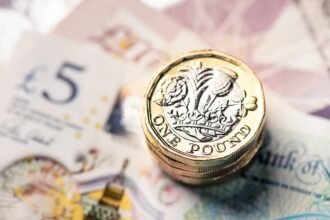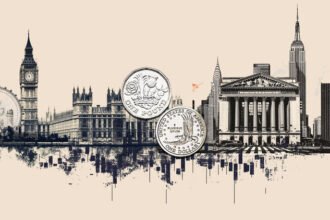- GBP/USD trades deep in negative territory below 1.3500 on Tuesday.
- The ILO Unemployment Rate in the UK rose to its highest level in nearly four years.
- The technical outlook highlights a buildup of bullish momentum.
GBP/USD stays under heavy bearish pressure on Tuesday and trades below 1.3500 as Pound Sterling struggles to find demand after the April employment report. The technical outlook suggests that the pair could extend its slide in the near term.
British Pound PRICE Today
The table below shows the percentage change of British Pound (GBP) against listed major currencies today. British Pound was the weakest against the Swiss Franc.
| USD | EUR | GBP | JPY | CAD | AUD | NZD | CHF | |
|---|---|---|---|---|---|---|---|---|
| USD | 0.16% | 0.45% | 0.06% | 0.08% | 0.12% | 0.11% | -0.04% | |
| EUR | -0.16% | 0.30% | -0.12% | -0.06% | -0.02% | -0.04% | -0.18% | |
| GBP | -0.45% | -0.30% | -0.47% | -0.36% | -0.32% | -0.35% | -0.48% | |
| JPY | -0.06% | 0.12% | 0.47% | 0.05% | 0.03% | -0.02% | -0.17% | |
| CAD | -0.08% | 0.06% | 0.36% | -0.05% | 0.03% | 0.02% | -0.12% | |
| AUD | -0.12% | 0.02% | 0.32% | -0.03% | -0.03% | -0.00% | -0.16% | |
| NZD | -0.11% | 0.04% | 0.35% | 0.02% | -0.02% | 0.00% | -0.14% | |
| CHF | 0.04% | 0.18% | 0.48% | 0.17% | 0.12% | 0.16% | 0.14% |
The heat map shows percentage changes of major currencies against each other. The base currency is picked from the left column, while the quote currency is picked from the top row. For example, if you pick the British Pound from the left column and move along the horizontal line to the US Dollar, the percentage change displayed in the box will represent GBP (base)/USD (quote).
The UK’s Office for National Statistics reported on Tuesday that the ILO Unemployment Rate rose to 4.6% in the three months to April. This marked the highest reading since June 2021. Other details of the report showed that the annual wage inflation, as measured by the change in the Average Earnings Excluding Bonus, softened to 5.2% from 5.5%. This print came in below the market expectation of 5.4%. Pound Sterling struggles to find demand as investors assess the rising unemployment level and softer wage inflation as important factors that could lead to more Bank of England (BoE) rate cuts later this year.
Meanwhile, the US Dollar (USD) gathers strength against its rivals on growing optimism about the United States (US) and China resolving the trade dispute. Negotiators are scheduled to meet for a second day in London on Tuesday. Late Monday, the Wall Street Journal reported that US President Donald Trump gave his representatives, led by Treasury Secretary Scott Bessent, room to lift export controls on a variety of Chinese products.
In the absence of high-tier data releases, headlines surrounding the US-China trade talks could drive the USD’s performance. A positive outcome is likely to support the USD and further weigh on GBP/USD.
GBP/USD Technical Analysis

The Relative Strength Index (RSI) indicator on the 4-hour chart declined below 40 and GBP/USD closed the last 4-hour candle well below 20-period and the 50-period Simple Moving Averages (SMA), pointing to a buildup of bearish momentum.
GBP/USD faces a pivot level at 1.3500, where the 100-period SMA is located. In case the pair confirms this level as resistance, 1.3400 (200-period SMA) could be seen as next support before 1.3360 (lower limit of the ascending channel). Looking north, resistances could be spotted at 1.3540-1.3550 (20-period SMA, 50-period SMA) and 1.3600 (mid-point of the ascending channel, static level).
Pound Sterling FAQs
The Pound Sterling (GBP) is the oldest currency in the world (886 AD) and the official currency of the United Kingdom. It is the fourth most traded unit for foreign exchange (FX) in the world, accounting for 12% of all transactions, averaging $630 billion a day, according to 2022 data.
Its key trading pairs are GBP/USD, also known as ‘Cable’, which accounts for 11% of FX, GBP/JPY, or the ‘Dragon’ as it is known by traders (3%), and EUR/GBP (2%). The Pound Sterling is issued by the Bank of England (BoE).
The single most important factor influencing the value of the Pound Sterling is monetary policy decided by the Bank of England. The BoE bases its decisions on whether it has achieved its primary goal of “price stability” – a steady inflation rate of around 2%. Its primary tool for achieving this is the adjustment of interest rates.
When inflation is too high, the BoE will try to rein it in by raising interest rates, making it more expensive for people and businesses to access credit. This is generally positive for GBP, as higher interest rates make the UK a more attractive place for global investors to park their money.
When inflation falls too low it is a sign economic growth is slowing. In this scenario, the BoE will consider lowering interest rates to cheapen credit so businesses will borrow more to invest in growth-generating projects.
Data releases gauge the health of the economy and can impact the value of the Pound Sterling. Indicators such as GDP, Manufacturing and Services PMIs, and employment can all influence the direction of the GBP.
A strong economy is good for Sterling. Not only does it attract more foreign investment but it may encourage the BoE to put up interest rates, which will directly strengthen GBP. Otherwise, if economic data is weak, the Pound Sterling is likely to fall.
Another significant data release for the Pound Sterling is the Trade Balance. This indicator measures the difference between what a country earns from its exports and what it spends on imports over a given period.
If a country produces highly sought-after exports, its currency will benefit purely from the extra demand created from foreign buyers seeking to purchase these goods. Therefore, a positive net Trade Balance strengthens a currency and vice versa for a negative balance.





















